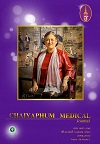ปัจจัยเสี่ยงที่สัมพันธ์กับการเกิดภาวะขาดออกซิเจนในทารกแรกเกิด โรงพยาบาลชัยภูมิ : Risk Factors Associated with Birth Asphyxia in Chaiyaphum Hospital
บทคัดย่อ
บทคัดย่อ
การวิจัยเชิงวิเคราะห์แบบย้อนหลังครั้งนี้ มีวัตถุประสงค์เพื่อศึกษาปัจจัยเสี่ยงที่สัมพันธ์กับการเกิดภาวะขาดออกซิเจนในทารกแรกเกิด โรงพยาบาลชัยภูมิ กลุ่มตัวอย่างคือ หญิงตั้งครรภ์ที่มาคลอดในโรงพยาบาลชัยภูมิ ระหว่างวันที่ 1 ธันวาคม 2557 ถึง 30 มิถุนายน 2558 ที่มีอายุครรภ์ ≥ 28 สัปดาห์ ทารกต้องมีชีวิต ไม่พิการ มีน้ำหนักแรกคลอด 1,000 กรัมขึ้นไป มีประวัติในเวชระเบียน และบันทึกการคลอดครบถ้วน โดยแบ่งกลุ่มตัวอย่างออกเป็น 2 กลุ่ม คือกลุ่มศึกษา เลือกกลุ่มตัวอย่างแบบเจาะจง (Purpose Sampling) ได้แก่ มารดาที่คลอดบุตรที่ประเมินคะแนนแอปการ์ ที่ 1 นาที น้อยกว่าหรือเท่ากับ 7 จำนวน 40 ราย และกลุ่มควบคุม ทำการสุ่มแบบง่าย (Simple random sampling) เรียงตามลำดับเวลาที่คลอด ได้แก่ มารดาที่คลอดบุตรที่ประเมินคะแนนแอปการ์ ที่ 1 นาที มากกว่า 7 จำนวน 80 ราย รวมทั้งสิ้น 120 ราย จากจำนวนมารดาที่คลอดบุตรมีชีพทั้งหมด 1,934 ราย คิดเป็นอัตราส่วนกลุ่มศึกษาต่อกลุ่มควบคุมเท่ากับ 1: 2 เก็บรวบรวมข้อมูลจากเวชระเบียนผู้ป่วยในและสมุดบันทึกการคลอด วิเคราะห์ข้อมูลปัจจัยเสี่ยงที่สัมพันธ์กับการเกิดภาวะขาดออกซิเจนในทารกแรกเกิด ด้วยสถิติอนุมาน (Inferential statistic ) ใช้การทดสอบไคส์แควร์ (Chi-square) และ Fisher’s Exact Test
ผลการศึกษา พบว่า ปัจจัยเสี่ยงที่สัมพันธ์กับการเกิดภาวะขาดออกซิเจนในทารกแรกเกิด อย่างมีนัยสำคัญทางสถิติ ได้แก่ มารดาที่มีปัจจัยเสี่ยง อายุครรภ์ < 37 สัปดาห์ มารดามีภาวะความดันโลหิตสูง รกลอกตัวก่อนกำหนด การได้รับยา Oxytocin มีภาวะคับขันในครรภ์ และทารกน้ำหนักแรกคลอดน้อยกว่า 2,500 กรัม
Abstract
The aimed of this Retrospective Analytical study were to investigate risk factors associated with birth asphyxia in a newborn at Chaiyaphum Hospital. The samples were pregnant women who had delivery between 1 December 2014 to 30 June 2015 at Chaiyaphum Hospital and gestational age greater than or equal to 28 weeks, infant lived birth, cases without fetal malformations, birth weight greater than or equal to 1,000 grams, completed medical and labor record, The samples had two group, including the studies were 40 cases of purpose sampling all pregnant women who delivered normal newborns with birth asphyxia with 1- minute APGAR score less than or equal to 7. The controls were 80 cases of randomized simple random sampling pregnant women who delivered normal newborns without birth asphyxia with 1- minute APGAR score more than 7. There were 1,934 deliveries during the study period. The ratio of the control group was 1:2 with 40 study cases and 80 controls, a total of 120 cases. Collecting data by medical and labor records. The data were analyzed in terms of Chi-square and Fisher’s Exact test.
The Result revealed that there were significant risk factors associated with birth asphyxia including maternal risk factors, gestational age less than 37 weeks, maternal hypertension, abruptio placenta, maternal received oxytocin, fetal distress and birth weight less than 2,500 grams.
ดาวน์โหลด
เผยแพร่แล้ว
เวอร์ชัน
- 2021-09-02 (2)
- 2019-07-30 (1)
ฉบับ
บท
การอนุญาต
ลิขสิทธิ์ (c) 2019 ชัยภูมิเวชสาร

This work is licensed under a Creative Commons Attribution-NonCommercial-NoDerivatives 4.0 International License.





